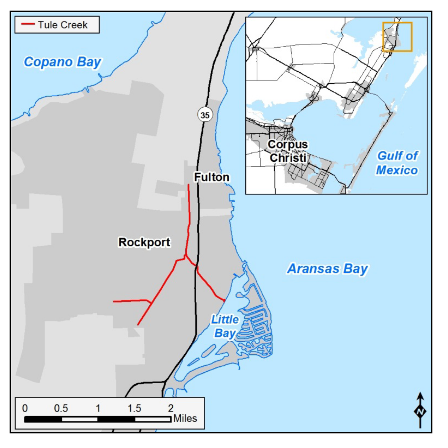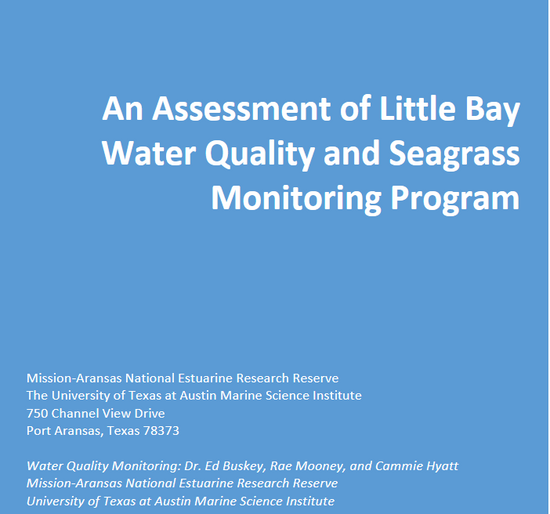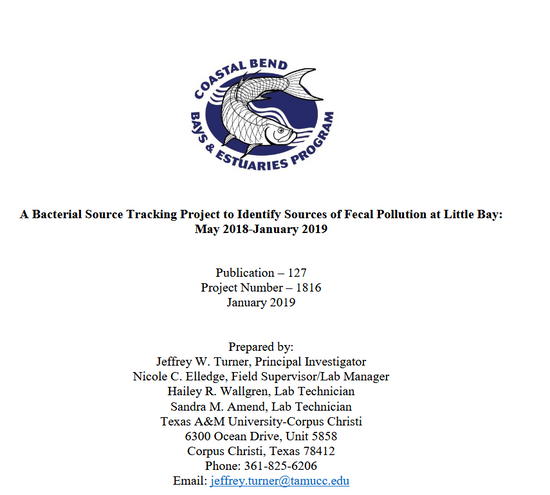OUR MISSION: Our goal is to bring awareness to modern issues that are destroying Little Bay to ensure it will be healthy and vibrant for the generations to come.
ONE THING IS FOR SURE, EVERYONE LOVES LITTLE BAY in ROCKPORT, TEXAS!
BUT, DID YOU KNOW...
1. The treated sewage from the City of Rockport Waste Water Treatment Plant - up to 2.5 million gallons per day - is drained into Little Bay via Tule Creek?
2. The majority of all stormwater drainage in Rockport drains directly into Little Bay?
Little Bay
-

ACND - Little Bay Drainage Improvement Project - Dec 6 2021
Read the full Analysis HereAlternatives Analysis - Have you heard about the different ideas on how to improve drainage and flow in Little Bay - here is the in depth study on the different options.
-

GLO - TX Coastal Resiliency - TAC Meeting
Read and see meeting info hereMay 13, 2025 Meeting
Texas General Land Office - Region 3
Project 9059 - Little Bay Restoration Initiative
-

Little Bay Final Report
Read the full report hereTexas Water Resources Institute report
September 2024
Elevated enterococci levels are frequently reported in Little Bay, particularly after storm events. Such events can introduce stormwater runoff to the environment and lead to the resuspension of sediment, which is a known reservoir of enterococci (Manini et al., 2022). Another pathway in which enterococci can enter this watershed is through Tule Creek, a manmade riparian buffer that transports treated wastewater effluent before it enters Little Bay. Previous work has identified significantly higher levels of enterococci within Tule Creek compared to Little Bay, which in turn was higher than the larger Aransas Bay (Powers et al., 2021a).
Tule Creek
-

Tule Creek Stormwater Retrofit (Dec 19 2023)
Read full study hereAnchor QEA, LLC, was retained by the Meadows Center for Water and the Environment at Texas State University to design a stormwater retrofit along Tule Creek in Rockport, Texas. The primary goal of the project is to improve water quality by reducing sediment and nutrient loading to Little Bay.
The project does not have quantitative goals for sediment or nutrient retention but is designed to retain as much sediment and nutrients as practicable, given property ownership and ecological constraints.
-

Tule Creek - 60% Design Submittal
Read and see retrofit plan hereTule Creek Stormwater Retrofit - The Meadows Center
-
Tule Creek Storm Runoff
The Tule Creek watershed drains areas of the City of Rockport and the Town of Fulton. The area population and impervious cover are expected to increase in the next two decades, causing an associated increase in
storm water runoff. Scientists have identified polluted storm water runoff as a principle cause of declining water quality and loss of
wildlife habitat within Little Bay, which Tule Creek flows into.
-

Tule Creek Storm Runoff
READ TCEQ REPORT HEREThe Tule Creek watershed drains areas of the City of Rockport and the Town of Fulton. The area population and impervious cover are expected to increase in the next two decades, causing an associated increase in storm water runoff. Scientists have identified polluted storm water runoff as a principle cause of declining water quality and loss of wildlife habitat within LittleBay, whichTule Creek flows into.
-

Mission Aransas Study
READ THE FULL REPORT HERE"The higher chlorophylla concentrations in Little Bay are of concern, and indicate that excess nutrients from Tule Creek are being rapidly taken up by phytoplankton, leading to additional phytoplankton biomass and reduced water clarity"
-
TX COMMISSION ON ENVIRONMENTAL QUALITY
READ MORE ABOUT ROCKPORT WASTEWATER TREATMENT PLANTThe Waste Water Department also operates a 2.5 MGD (Million Gallons per
Day) Waste Water Treatment Plant. The waste water treatment plant is
operated under the regulatory guidelines of the Texas Commission on
Environmental Quality and the United States Environmental Protection
Agency. -
EPA FECAL TEST REPORT - LITTLE BAY
SEE DETAILED REPORT HERETexas Beach Watch Historical Water Quality Data
The Texas General Land Office (GLO) annually reports water quality data for Texas beaches to the U.S. Environmental Protection Agency (EPA).
The most recent report submitted contained the 2020 data. The 2021 data will be reported to EPA in January 2022.To access historic water quality data, the EPA created the Beach Advisory and Closing Online Notification (BEACON),
an online system to meet the Agency's requirement to provide to the public a database of pollution occurrences for coastal recreation waters. -
Waste Treatment water drains to Little Bay
READ PERMIT HEREpage 4 - The City of Rockport through TCEQ is permitted to discharge up to 2,500,000 gallons of wastewater to Little Bay via Tule Creek.
-

2019 Texas A&M CC
READ THE FULL REPORT HERE"We recommend that future efforts to remediate the bacterial pollution in LittleBay focus on four best-management practices (BMPs).
1. Wastewater effluent should be diverted through a larger riparian buffer that terminates into Aransas Bay.
2. A pet waste outreach program should aim to limit canine fecal waste.
3. The loitering of gulls should be addressed through policies that prohibit feeding of gulls and limit improper food waste disposal.
4. The repair and maintenance of sanitary sewer systems and septic systems should be ensured to limit episodic leaks that may contribute to spikes in human fecal pollution."
-
STORMWATER RUNOFF - TULE CREEK
READ THE WATERSHED REPORT HERE"The Tule Creek watershed occupies approximately 2,340 acres in Rockport (Live Oak Peninsula) ... The Rockport Country Club is located in the middle of the wateshed ... the entire area discharges to Little Bay." pg 8











